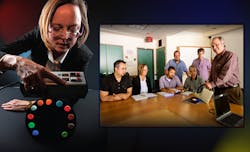New fluorescent-lighting phosphors consume far less rare earths
General Electric (GE), Lawrence Livermore National Laboratory (LLNL), and Oak Ridge National Laboratory (ORNL) have created new kinds of fluorescent-lighting phosphors that use far less rare-earth elements than current technology. Rare-earth elements are hard to come by and the United States has access to a limited amount of rare-earth elements and relies on imports.
RELATED ARTICLE: Chemical element availability impacts the future of photonics
Today the phosphors in fluorescent lighting consume more than 1,000 metric tons of rare-earth oxides yearly, including europium (Eu), terbium (Tb), cerium (Ce) and lanthanum (La), as well as even larger amounts of yttrium (Y) oxide.
While LED lighting will likely replace fluorescent tubes eventually, low-cost linear fluorescent lighting is expected to remain a dominant feature in the U.S. infrastructure for more than a decade. Therefore it is necessary to replace the current triphosphor blend discovered more than 30 years ago (based on a mixture of blue, green, and red emitters) because of its high rare earth consumption.
The GE, LLNL and ORNL team, funded by the Department of Energy's Office of Energy Efficiency and Renewable Energy and working with the Critical Materials Institute (CMI) at Ames Laboratory, have identified a green phosphor, which reduces the Tb content by 90% and eliminates La, while the new red phosphor eliminates both Eu and Y and is rare-earth free.
These proposed phosphors appear to be close to meeting stringent requirements of long lamp survivability, high efficiency, precise color rendition and low-cost; the blue phosphor has inherently low rare-earth content and need not be replaced.
"The fundamental physics of these phosphors is compelling, and we are taking the next steps to assess their feasibility for commercial lighting by evaluating chemical issues such as slurry compatibility and improving the synthetic procedures," said Steve Payne, the CMI thrust leader on the project. The principal investigators on the project are Nerine Cherepy of LLNL, Lynn Boatner of ORNL and Alok Srivastava of GE.
SOURCE: LLNL; https://www.llnl.gov/news/better-fluorescent-lighting-through-physics

Gail Overton | Senior Editor (2004-2020)
Gail has more than 30 years of engineering, marketing, product management, and editorial experience in the photonics and optical communications industry. Before joining the staff at Laser Focus World in 2004, she held many product management and product marketing roles in the fiber-optics industry, most notably at Hughes (El Segundo, CA), GTE Labs (Waltham, MA), Corning (Corning, NY), Photon Kinetics (Beaverton, OR), and Newport Corporation (Irvine, CA). During her marketing career, Gail published articles in WDM Solutions and Sensors magazine and traveled internationally to conduct product and sales training. Gail received her BS degree in physics, with an emphasis in optics, from San Diego State University in San Diego, CA in May 1986.
